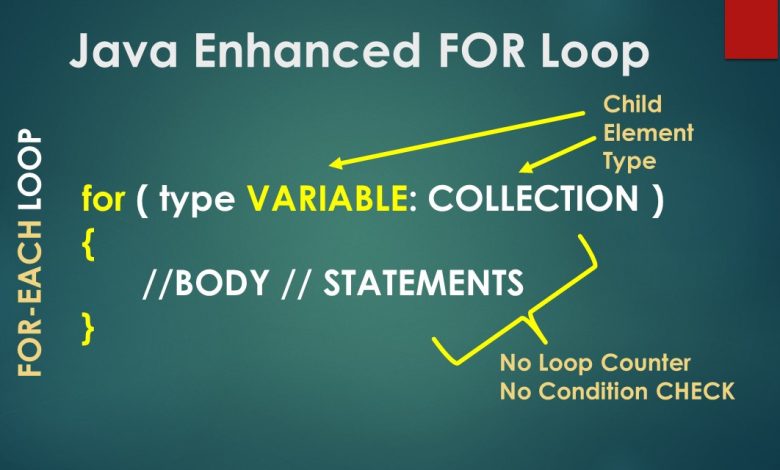Java Enhanced For Loop: Simplifying Iteration and Enhancing Readability
Java Enhanced For Loop

Java, as a powerful and versatile programming language, offers several constructs to iterate over collections and arrays. One such construct is the enhanced for loop, also known as the “for-each” loop. Introduced in Java 5, the enhanced for loop simplifies the process of iterating through elements and enhances code readability. In this article, we will explore the features, benefits, and best practices of using the Java enhanced for loop.
Syntax and Usage
The enhanced for loop in Java follows a concise syntax that makes it easy to read and understand. The general form of the enhanced for loop is:
(elementDataType element : collection) {
// Code block
}
Here, elementDataType represents the data type of the elements in the collection, and collection refers to the array or iterable collection being traversed. Within the loop, the individual elements are accessed using the element variable.
Simplifying Iteration
One of the key advantages of the enhanced for loop is its ability to simplify iteration over collections and arrays. It eliminates the need to manually manage the loop index, which often leads to off-by-one errors and increases code complexity. By abstracting away the loop index, the enhanced for loop provides a more intuitive and concise way to iterate through elements.
For example, consider the following code snippet that uses a traditional for loop to iterate over an array of integers:
int[] numbers = {1, 2, 3, 4, 5};
for (int i = 0; i < numbers.length; i++) {
int number = numbers[i];
System.out.println(number);
}
Using the enhanced for loop, the same iteration can be achieved with fewer lines of code:
int[] numbers = {1, 2, 3, 4, 5};
for (int number : numbers) {
System.out.println(number);
}
As demonstrated, the enhanced for loop eliminates the need for index management, leading to cleaner and more readable code.
Support for Iterable Collections
In addition to arrays, the enhanced for loop is compatible with any class that implements the Iterable interface. The Iterable interface defines a method called iterator(), which enables the enhanced for loop to traverse the elements of the collection.
By supporting iterable collections, the enhanced for loop provides a unified approach to iterate over various data structures such as lists, sets, and queues. This versatility enhances code reusability and promotes a consistent programming style.
Enhanced for Loop and Readability
Code readability is a crucial aspect of software development. By using the enhanced for loop, developers can write more expressive code that is easier to understand and maintain. The enhanced for loop’s simplicity and clarity contribute to improved readability, especially when dealing with complex data structures.
Consider the following example, where we iterate over a list of strings and perform some operations:
List<String> fruits = Arrays.asList("Apple", "Banana", "Orange");
for (String fruit : fruits) {
if (fruit.equals("Apple")) {
System.out.println("An apple a day keeps the doctor away!");
} else {
System.out.println("I like " + fruit + "s.");
}
}
The enhanced for loop makes it evident that we are iterating over the list of fruits and performing different actions based on the current element. This clarity greatly aids in code comprehension and reduces the chances of introducing errors.
Limitations of the Enhanced For Loop
While the enhanced for loop offers significant benefits, it does have some limitations. The enhanced for loop does not provide direct access to the loop index, making it unsuitable when the index value is needed for specific operations. In such cases, using a traditional for loop is more appropriate.
Conclusion
The Java enhanced for loop is a powerful construct that simplifies the process of iterating over collections and arrays. By eliminating the need for explicit index management, it reduces code complexity and enhances code readability. Its compatibility with iterable collections promotes a consistent programming style across different data structures. However, it’s essential to be aware of its limitations, such as the lack of direct access to the loop index. By leveraging the enhanced for loop effectively and understanding its best practices, developers can write more concise and maintainable Java code.



